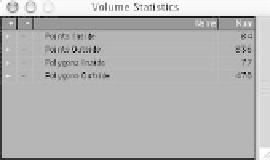Graphics Programs Reference
In-Depth Information
Figure 3-11: The Volume Statistics
window.
Figure 3-10: The Point Statistics window.
Changing the selection mode to Points
makes the Statistics window display point
statistics.
The Point Statistics window for the
Katana object tells us:
•
Total
— There are 920 total points in
this object.
•
0 Polygons
— There are no points
that don't belong to any polygons (usually
leftovers or mistakes, though there are
times when you will want to have a point
without a poly).
•
1 Polygons
— There are 68 points
that belong to only one polygon each.
•
2 Polygons
— There are 322 points
that are shared between two polygons.
•
3 Polygons
— There are 86 points
that are shared among three polys.
•
4 Polygons
— There are 444 points
that are shared among four polys.
•
>4 Polygons
— There are no points
that are shared among more than four
polys.
•
Tang
— There are 123 points that
belong to the point selection group Tang.
(This is a pop-up menu that lists all the
point selection sets you've created for the
object.)
The Volume Statistics window tells you
how many points and polys fall inside and
outside the (right-click-lassoed) selection
area when the selection mode is set to
Volume.
Note
The easiest way to understand the difference
between Include and Exclude Volume selec-
tion mode is to lasso only part of your model
and, using the “+” and “-” buttons in the
Volume Statistics window, add and remove
polygons from your selection.
•
Exclude
— A polygon that has some points
inside
and
some points
outside
the Volume
Selection Area
is not
considered part of the
selection.
•
Include
— A polygon that has some points
inside
and
some points
outside
the Volume
Selection Area
is
considered part of the
selection.
The Statistics window also shows informa-
tion about the items you currently have
selected.







